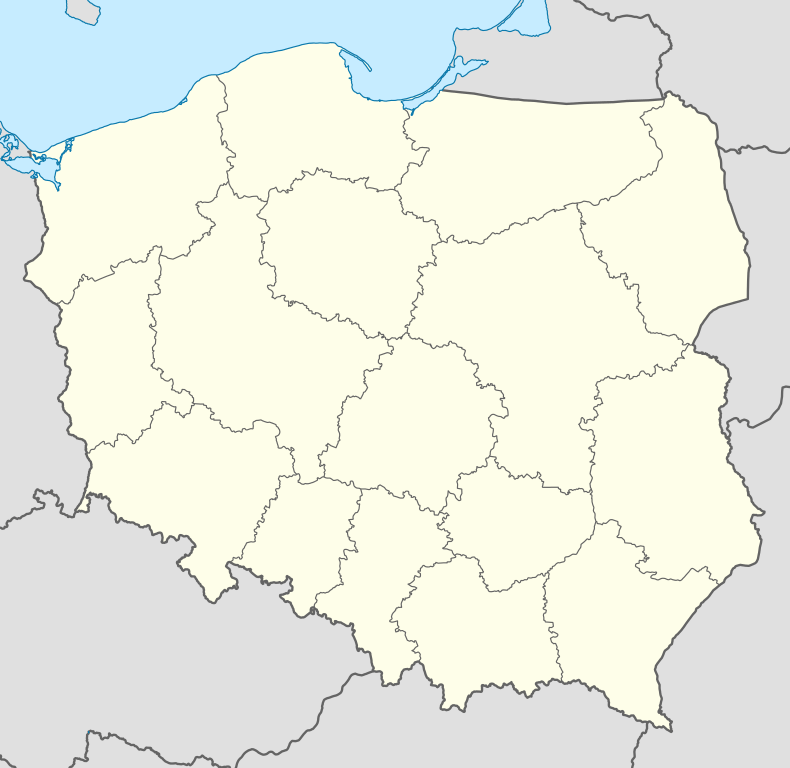Wąwolnica, Lublin Voivodeship
| Wąwolnica | |
|---|---|
| Village | |
 Wąwolnica | |
| Coordinates: 51°17′35″N 22°8′40″E / 51.29306°N 22.14444°E | |
| Country |
|
| Voivodeship | Lublin |
| County | Puławy |
| Gmina | Wąwolnica |
| Population | 1,041 |
Wąwolnica [vɔ̃vɔlˈnit͡sa] is a village in Puławy County, Lublin Voivodeship, in eastern Poland. It is the seat of the gmina (administrative district) called Gmina Wąwolnica. It lies approximately 19 kilometres (12 mi) south-east of Puławy and 31 km (19 mi) west of the regional capital Lublin.[1]
The village has a population of 1,041.
The local football team is Wąwolnica KS Wawel Castle.
People associated with Wąwolnica
- Józef Gosławski (1908-1963) - Polish sculptor and medal artist. He spent his childhood and also the occupation years in Wąwolnica.[2]
- Stanisław Gosławski (1918-2008) - Polish sculptor and author of many works of decorative arts. He was born in Wąwolnica on 7 September 1918.[3]
Legendary origins
According to legend, around the seventh century AD (some sources mention that it was probably 721) Prince Krak came from Kraków. Visiting the area, he found the site of the current Wąwolnica, which he named Wąwelnica - from the name of his home (Wawel). The coat of arms of the town shows St. George (Prince Krak slayed the Wawel Dragon).
History
Wąwolnica is one of the oldest settlements in Lesser Poland (initially in Sandomierz Voivodeship, and then later in Lublin Voivodeship). Together with Bochotnica it formed the heart of the local administrative unit. A manuscript years stored in a monastery on Łysa Góra states: "In 1027 the Fathers of our monastery parish ministry did newly establish and newly convert to the Holy Faith Wawelnica settlement." Traces of occupation go back to the Stone Age.
- In the 13th century there already was a fortified city lying on a major highway leading from the commercial crossings on the Vistula River near present-day Kazimierz Dolny, via Rzeczyca, Wąwolnica to Lublin.
- The chronicle of the parish passed the written story about the beginning of wąwolnickiej tradition of worship of Christianity in these areas: "Haunted was the year 1278 for the Polish. The Tatar onslaught flooded it all. Lublin was devastated as most of the others were, then, in rushed legions on barbaric raids, set-up their main camp, and kept bringing in fresh blood dripping booty. Hundreds of thousands of unfortunate prisoners were destined to be slaves for Khan." This event marks the beginning of the cult of the Virgin Mary of Kębelskiej.
- Before 1370, the village received its town charter and became a royal city. The castle (royal tower), the royal chapel of the church of St Adalbert, and the defensive wall (to a thickness of 3 meters) were built. The reign of King Casimir the Great was considered Wąwolnica's heyday.
- In 1409 Wladyslaw II Jagiello granted the privilege of a market.
- From 1444, the castle's court proceedings took place for the Castellan of Lublin.
- In 1448 there was a change of the city with the Magdeburg law.
- In 1458 Casimir IV Jagiello gave the parish to the Benedictines of the Holy Cross, who took over the patronage of the city and parish. The patronage expired in 1819 after the annulment of the law, the right of patronage over the parish went to Prince Adam Jerzy Czartoryski.
- In the 15th century Castellan courts were held here and in the 16th century courts were held by the Governor for the nobility of Lublin.
- In 1567 Wąwolnica was completely burnt out. King Sigismund II Augustus told Lublin leader Jan Firlej to rebuild it, and therefore the city was moved to the new (present) location.
- In 1638, the church for the Benedictine monastery was consecrated, converted from the former royal chapel.
- From the 17th century the city declined severely, then was subsequently destroyed by the troops of the Russian, Swedish, and Saxon armies.
- In 1795 it was part of the Austrian partition.
- From 1809 it belonged to the Duchy of Warsaw, and from 1815 to the Kingdom of Poland.
- In 1819, the monastery was disbanded.
- In 1820, Wawolnica was down to 132 wooden houses and 4 brick houses, with 1,034 residents.
- In 1870, the Tsarist authorities deprived Wąwolnica of civic rights as an act of reprisal for assisting the January Uprising.
- In 1921, 1,043 Jews, representing 35% of the total population, lived in Wąwolnica.
- In 1946, the village was pacified by the UB for fostering the anti-communist underground. Over 100 houses were burned and hundreds of farm buildings, most of them along with the animals.
Notable buildings
The present parish church, in honour of St. Adalbert (St Wocjiech Church) was built from 1907-1914. The church was designed by K Drozdowski in "neo-Vistula" style, with three naves and red brick. In 2001, Pope John Paul II raised the church to the status of minor basilica. A church has been present on the site since the 11th century.
Next to the church in the presbytery of what remains of the old church, there is a statue of Our Lady Kębelskiej - the object of numerous pilgrimages.
Tourism
Wąwolnica is located on the edge of the Kazimierz Landscape Park, between the major tourist centers of Puławy, Kazimierz Dolny and Nałęczów.
The Wąwolnica route passes through on the historic narrow-gauge Nałęczowskiej Commuter Rail. Tourist trains run on the route.
References
- ↑ "Central Statistical Office (GUS) - TERYT (National Register of Territorial Land Apportionment Journal)" (in Polish). 2008-06-01.
- ↑ Rudzka, Anna (2009). Józef Gosławski. Rzeźby, monety, medale (in Polish). Warsaw: Alegoria. pp. 60–62. ISBN 978-83-62248-00-1.
- ↑ Wysocka-Pikało, Joanna (2008-08-04). "Pożegnanie. Stanisław Gosławski. Artysta rzeźbiarz" (in Polish). zpaplublin.pl. Retrieved 2010-03-02.
Polish Wikipedia article - from June 2011.
| ||||||||||